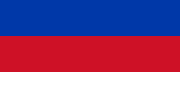Flag of Saxony
The flag of the Free State of Saxony consists of a horizontally divided white-green bicolor. The official flag of the Free State, which is carried by state agencies, also bears the Saxon coat of arms . It was reintroduced on October 3, 1990 with the re-establishment of the Free State of Saxony.
In Article 2 of the Saxon Constitution , paragraph 2 states:
- The national colors are white and green.
In paragraph 4 the following is added:
- In the settlement area of the Sorbs , in addition to the state colors and the state coat of arms, the colors and coat of arms of the Sorbs , in the Silesian part of the country the colors and the coat of arms of Lower Silesia can be used equally.
The Saxon state parliament has its own variant of the state flag with an applied state coat of arms in baroque form, as it is used as the state parliament's service coat of arms.
Flag of the Saxon State Parliament
history
The house colors of the old Saxon or Markmeißnischen ruling dynasty of the Wettins were originally yellow and blue. The colors can also be found in the motif of the Landsberg stakes as the coat of arms of the Margraviate Landsberg , the actual home of the Wettins. It has found its way into many city coats of arms in today's Saxony ( Leipzig , Chemnitz , Delitzsch etc.). Since the middle of the 13th century, the black Meißner lion on a golden background prevailed as a Wettin symbol of rule. Flags in today's sense did not exist at that time, if at all the coat of arms was carried as a so-called coat of arms banner .
When the Saxon electoral dignity was obtained in 1423, the Saxon coat of arms replaced the Meissner lion as the primary symbol of power, often in combination with the swords of the imperial racing flag to symbolize the arch marshal's office. From the Saxon coat of arms, as so often, the black and yellow colors, which were primarily used until 1815, were derived. The flag colors in the coat of arms also have their origin in Prussia (black and white) or Bavaria (white and blue). Even though the bicolor or tricolor flags that are mostly found on flags today did not become established until the end of the 18th century, when the meaning of flags gradually changed from a pure symbol of rule of the monarch to a symbol of the state itself.
After the Wars of Liberation , which Saxony lost to the side of the Confederation of the Rhine , which was allied with France , and the Congress of Vienna in 1815, white and green became the national colors. The change after the costly battles in the wars of liberation demonstrated a new beginning. The Prussian province of Saxony , which later emerged from the Saxon assignments of territory (including the Kurkreis), relied on the Saxon coat of arms and the colors black and yellow. The state of Saxony-Anhalt still uses a black and yellow bicolor today .
The colors white and green are taken from the cockades of the Saxon troops. Traditionally they wore white cockades . As a result of the Battle of the Nations and Napoleon's retreat, Saxony was placed under Allied, first Russian and later Prussian governorate . The Russian general Thielmann , who had quit the Saxon service out of frustration at the hesitant attitude of the king, obtained a change of cockade as the new commander of the Saxon army, which was to be re-established under Allied command:
- " Se. emperor. The Majesty of all Russians, on my most submissive suggestion, deigned to approve that the Saxon troops should wear the national color as their standard. It is the green one after the diamond wreath of the Saxon coat of arms. The cocarde is now green, and should be surrounded with a yellow and a black stripe in memory of the liberators of Germany and the restorers of the fatherland. The porte-epee and hat cordons are of silver with green, yellow, and black stripes. - Leipzig, November 13th, 1813. The kaiserl. Russian Lieutenant General and Commandant of the Saxon Army Freiherr v. Thielmann "
While the Ernestine Grand Duchy of Saxony-Weimar-Eisenach , which was closely related to the Tsar's house due to the marriage of Hereditary Prince Carl Friedrich and the sister of the Russian Emperor Alexander I , Maria Pawlowna , led a combination of black, green and yellow until 1918 - based on the Saxon green and the imperial Russian black and yellow, this did not prevail in the Kingdom of Saxony. Only the green " Saxon national color " was taken up and finally added to the traditional white cockades by order of the king after the division of the Saxon army on May 22, 1815 for better differentiation. In this way, tradition was preserved on the one hand and a new beginning was marked on the other. In the Battle of Nations, Saxon troops had defected to the Allies against the king's orders. The commitment of the Saxon army in the final defeat of Napoleon in the campaign of 1814/15 was intended to rehabilitate Saxony, but could not prevent the division of the country decided at the Congress of Vienna.
The new colors enjoyed great popularity among the population, who were still loyal to the king, but had also long since been nationally and anti-Napoleonic, especially among students. The new colors were first mentioned in literature in the second stanza of the student song " Where courage and strength flames in the German soul " by the Leipzig corps student Carl Hinkel :
" [...] 2. White as the king's head is our sign
And green the ribbon that draws our breasts
Green like the leaves of our German oaks,
Green like the hope that glows in the heart. [...] "
When the Saxon king returned from Allied captivity on June 7, 1815, the residence was decorated in white and green. He then officially declared the combination to be the new national colors.
All of the following Saxon states also use the white and green flag and the Wettiner coat of arms . In 1933/34 during National Socialism and in 1952 in the course of administrative reform in the GDR , the flag lost its function with the dissolution of Saxony until 1990. At demonstrations in the context of the Peaceful Revolution, in addition to the black, red and gold flags of Germany, the white and green flag of Saxony also shaped the scenery, which was perceived as a clear demand for the restoration of Saxon statehood.
Electorate of Saxony (until 1806)
Kingdom of Saxony (1806-1815)
Kingdom of Saxony (1815-1918)
Free State of Saxony (1918–1934)
State of Saxony (1945–1952)
In some cases, there are also depictions of the flag with the respective coat of arms of Electoral Saxony or, from 1806, the royal Saxon coat of arms.
Most of the Thuringian states that emerged from the Ernestine Saxon areas (see Leipzig division ) also used the colors black, yellow, green and white in their flags until the state of Thuringia was founded in 1920.
Web links
Individual evidence
- ↑ REVOSax state law Saxony - Constitution. Retrieved April 1, 2019 .
- ↑ [1] Instructions for the external flagging of the office buildings of the Saxon State Parliament from April 4, 2014.
- ^ Publicandum from Leipzig of November 15, 1813, in: Österreichischer Beobachter . A. Strauss, 1813, p. 1719 ( google.de [accessed December 19, 2017]).
- ^ Michael Richter : The formation of the Free State of Saxony: peaceful revolution, federalization, German unity 1989/90. Vandenhoeck & Ruprecht, Göttingen 2004, pp. 120f









